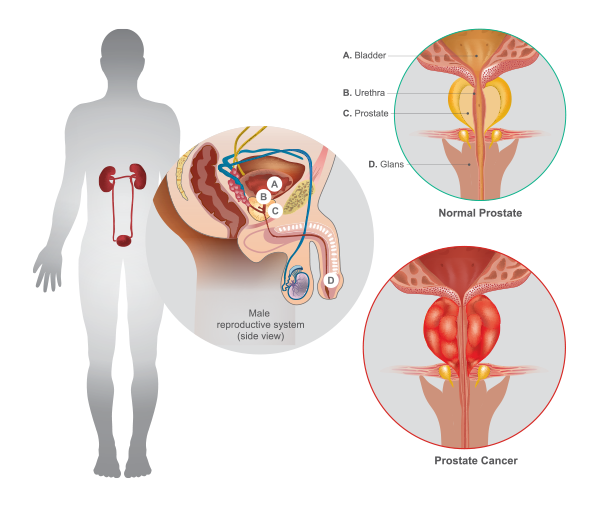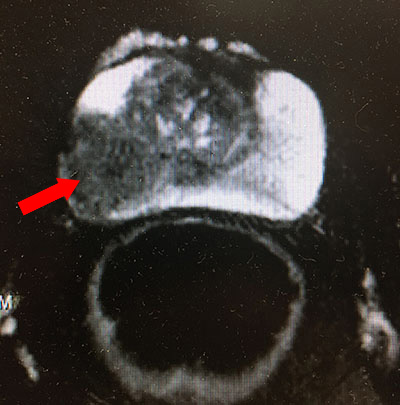
Prostate Cancer

Prostate cancer is one of the primary conditions treated by Dr. Ponsky. According to the American Cancer Society, about one in seven men will be diagnosed with prostate cancer during his lifetime. The disease usually develops in older men, with 66 being the average age of diagnosis.
The prostate gland is a small, walnut-shaped gland located below the bladder and in front of the rectum in men. Its job is to produce the seminal fluid that nourishes and transports sperm. Prostate cancer begins when cells in the prostate gland become abnormal and begin growing and dividing rapidly.
Typically, prostate cancers grow slowly, although some rare forms are more aggressive and can grow and spread quickly. When prostate cancer is detected early while still confined to the prostate gland, it has a better chance of successful treatment.
DIAGNOSIS AND TREATMENT
Dr. Ponsky offers advanced MRI imaging of the prostate, as well as in-gantry and fusion-targeted biopsies – the most precise diagnostic tools available to detect prostate cancer.
There are many types of treatments available for prostate cancer, depending on the type and stage of each particular patient. These options can include:
- Active Surveillance
- Surgery
- Radiation Therapy
- External Beam Radiation
- Proton Therapy
- Brachytherapy (seeds)
- Hormone Therapy
- Chemotherapy
- Immunotherapy

MRI Prostate Image With Tumor
New Technologies in Prostate Cancer
Same-Day Prostate Diagnosis
INNOVATIONS IN PROSTATE CANCER DIAGNOSIS
SAME-DAY DIAGNOSTIC PROGRAMS
What could be more nerve-wracking than waiting days, weeks – even months – to find out whether or not you have prostate cancer? Unfortunately, that is the traditional diagnostic timeframe. But because Dr. Ponsky understands the anxiety and the dread his patients go through, he is proud to offer advanced diagnostic tools and treatments that cut down wait time and provides excellent outcomes.
Dr. Ponsky offers one of the only programs in the world that can provide a same-day prostate diagnosis. Using advanced MRI imaging combined with MRI targeting technology and working closely with a pathologist and radiologist, Dr. Ponsky and his team can quickly and accurately establish the diagnosis. They will then review the results and develop a detailed treatment plan in one day.
ADVANCED IMAGING TECHNIQUES
In-Gantry Biopsy
The biopsy is actually directly performed during this MRI-guided biopsy procedure. This is the most accurate image-guided technique to diagnose prostate cancer. The approach allows us to more clearly visualize the tumor, therefore provide extremely precise and real-time guidance to ensure the most accurate targeting of the tumor.
Fusion-Targeted Biopsy
In this innovative procedure, we combine MRI and ultrasound to allow the team to more accurately locate and identify an abnormality easily seen on the MRI. We first obtain an advance MRI of the prostate. Next, using special fusion technology, the MRI image is fused in real time with the transrectal ultrasound image and this allows for more accurate targeting of the abnormal area identified on the MRI and the targeted biopsy is performed.
Active Surveillance Program
One of the greatest advancements in the management of prostate cancer in the last several years is the incorporation of Active Surveillance into the management of select patients with very low risk and low-risk prostate cancer. This program allows the patient and physicians to work as a team to closely and actively monitor the prostate cancer. Active Surveillance involves regularly monitoring the PSA through a blood test, MRIs of the prostate, and occasional repeat prostate biopsies. The goal is to avoid the need to treat for as long as possible, but still offering curative treatment options when necessary. There is recently published evidence that appropriately selected patients can be closely monitored 15 years without the need to be treated. This option isn’t for everyone, but we offer this to appropriate patients very often. This innovative program has significantly improved patients’ quality of life.
Virtual Biopsy
Dr. Ponsky introduced this concept called the virtual biopsy where he uses advanced imaging techniques to replace a prostate biopsy where appropriate.

